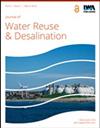改进的分光光度法选择性测定痕量尿素:在超纯水生产过程中的应用
IF 2.3
Q2 Environmental Science
引用次数: 5
摘要
常规分光光度法无法准确检测100μg/L以下的尿素浓度。采用改进的分光光度法测定半导体制造业超纯水生产过程中的微量尿素。根据化学试剂的用量、光路长度和水浴方式对该方法进行了优化。加入金属离子以提高显色体系的稳定性。在0.8–100μg/L范围内观察到具有理想线性的校准图。尿素的检测限和定量限分别为0.24和0.80μg/L。观察了UPW生产过程中尿素在原水中的分布,自来水中的尿素浓度为10-20μg/L。城市中水的尿素浓度为24-40μg/L,是工业中水浓度为10-18μg/L的两倍。UPW生产工艺对尿素的总去除率为50-70%。反渗透膜在去除尿素(超过30%)方面发挥着关键作用。自来水生产的最终UPW中的尿素约为4.1μg/L,这会产生总有机碳过量的潜在风险。本文章由计算机程序翻译,如有差异,请以英文原文为准。
A modified spectrophotometric method for selective determination of trace urea: application in the production process of ultrapure water
Conventional spectrophotometric methods were unable to accurately detect urea concentrations below 100 μg/L. A modified spectrophotometric method was developed to determine the trace urea in the ultrapure water (UPW) production process of the semiconductor manufacturing industry. This method was optimized based on the dosage of chemical agents, length of the optical path, and mode of the water bath. Metal ions were added to promote the stability of the chromogenic system. A calibration graph was observed with ideal linearity in the range of 0.8–100 μg/L. The detection and quantification limits of urea were 0.24 and 0.80 μg/L, respectively. The distribution of urea in raw water for the UPW production process was observed and the urea in tap water was 10–20 μg/L. The urea of municipal reclaimed water was 24–40 μg/L, which was twice that of industrial reclaimed water at 10–18 μg/L. The total removal rate of urea by the UPW production process was 50–70%. Reverse osmosis membranes played a critical role in the removal of urea (over 30%). The urea in the final UPW produced from tap water was approximately 4.1 μg/L, which creates a potential risk of excessive total organic carbon.
求助全文
通过发布文献求助,成功后即可免费获取论文全文。
去求助
来源期刊

Journal of Water Reuse and Desalination
ENGINEERING, ENVIRONMENTAL-WATER RESOURCES
CiteScore
4.30
自引率
0.00%
发文量
23
审稿时长
16 weeks
期刊介绍:
Journal of Water Reuse and Desalination publishes refereed review articles, theoretical and experimental research papers, new findings and issues of unplanned and planned reuse. The journal welcomes contributions from developing and developed countries.
 求助内容:
求助内容: 应助结果提醒方式:
应助结果提醒方式:


